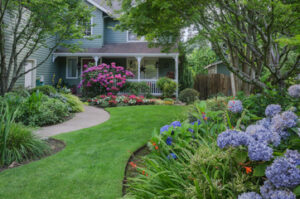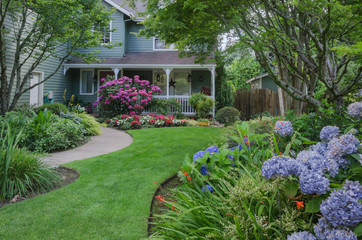Greensboro Landscaping adds aesthetic value to your property and creates functional outdoor spaces for a variety of purposes. It also contributes to a high quality of life with multiple physcial and psychological benefits.
Use texture to add depth and interest to your landscape design. For example, the stems, leaves, and trunks of plants all have different textures.
Lawn care involves a variety of tasks that work together to create a lush and beautiful lawn. These include soil preparation, seeding or sodding, watering, mowing, fertilization, and weed control. It is important to monitor the health and appearance of your lawn regularly and to take action when problems arise. Some treatments, such as mowing and watering, can be done manually with basic equipment like lawn mowers and hoses. Others, such as fertilization and pest control, require more specialized equipment and are often done by a professional.
Soil preparation is an important part of lawn care, as it improves the structure and fertility of the soil to allow for better grass growth. Amends to the soil, such as compost, lime or sulfur, can also help to adjust the pH of the soil, which is crucial for healthy grass growth. Seeding or sodding helps to fill in bare or damaged areas of the landscape, and should be done in spring or fall, depending on your area. Grass that has been seeded or sodded needs to be watered regularly and mowed at the appropriate height.
Fertilizing your lawn with the proper amount of nitrogen, phosphorous, and potassium is necessary for growth and development. These nutrients can be supplied by organic or synthetic sources. A soil test will indicate the types and amounts of nutrients your lawn requires.
Weeds and pests can be a significant problem in the landscape, causing damage to the plants and hindering their growth. Regular weed control, deer repellent, and crabgrass control can reduce these problems and promote the health of your landscape.
Proper maintenance of your lawn will help to protect the environment and add beauty to your home. By following these lawn maintenance tips, you can enjoy the benefits of a well-manicured lawn all year round. Contact Scientific Plant Service to learn more about our landscaping services and which treatments are recommended for your property. You can also inquire about our snow removal services, which help to prevent damage to your lawn from heavy winter snowfall and ice. We look forward to assisting you with all your landscaping and lawn care needs.
Fertilizing
Grass and other landscape plants require many different nutrients for proper growth and to develop flowers, fruit and seed. These nutrients are drawn up from the soil through their roots. Over time, the nutrient supply in the soil can be depleted, and fertilizing helps to replenish those nutrients. There are a number of different fertilizers available, and it is important to choose the right one for the type of plant you’re growing.
Fertilizers are available in both organic and synthetic forms. Organic fertilizers are made from natural, organic materials such as peat moss, manure, composted grass clippings, seaweed and other decaying plant material. Synthetic or chemical fertilizers are produced from inorganic substances such as rocks and minerals. Organic fertilizers provide a slow, steady source of nutrients to the soil and help to improve its texture and water holding capacity.
Nitrogen, phosphorous and potassium are the primary nutrients needed to grow healthy lawns. Organic or synthetic fertilizers are available that provide these nutrients in a balanced formula. Some also contain additional micronutrients, such as iron, manganese, copper and zinc, to promote a healthy root system. Ensure that your lawn is getting the nutrients it needs by following your soil test report and by applying the correct amount of fertilizer.
In addition to providing plant nutrition, well-fertilized landscapes have other benefits, including attracting earthworms and beneficial insects that will eliminate unwanted pests, saving you money in the long run. If you’re planting vegetables or other edible crops, be sure to use a vegetable-specific fertilizer and follow label directions for application. Avoid over-fertilizing, which can damage plants and pollute our local water systems.
When fertilizing woody plants, the nutrient requirement is typically determined by the DBH (diameter at breast height) of the tree or shrub and the root area in square feet. Using this method, fertilizer can be applied evenly across the entire root zone of the plant. When calculating the root area, do not include areas that will not be receiving fertilizer such as sidewalks and driveways. It is recommended that you apply a granular fertilizer and lightly water after application to ensure that the nutrients are absorbed by the soil.
Weed Control
Weed control is the management of unwanted plants in landscape planting beds, woodlots, gardens, ponds, driveways and other areas around homes. Weeds compete with desired vegetation for water, nutrients and sunlight, hindering growth, decreasing aesthetic quality and increasing maintenance costs. Weeds can also disrupt soil health and contribute to erosion and soil degradation. Proper weed control improves plant health, prevents nutrient depletion and helps maintain a tidy appearance that enhances property value.
There are many methods of weed control depending on the weed type and stage in its life cycle. Methods include physical removal, burning, herbicides, mulching, heating and crop rotation. Perennial weeds such as poison ivy and kudzu require consistent treatment.
Burning and steaming are effective for destroying small, young weeds that have not yet developed roots. These techniques must be used carefully because they can damage desirable plants as well. If you choose to use these methods, keep the flame away from flowers and other foliage. Herbicides are effective for eliminating established weeds and can be used to kill both annual and perennial weeds, but only if the proper precautions are followed. Always read the product label and follow the directions for application.
Managing weeds is an important part of landscaping and is particularly crucial in areas that are planted to shrubs, trees and other ornamental grasses. Weeds that compete with the desired plantings for water, nutrients and sunlight can stunt or even destroy their growth. Proper weed control reduces maintenance costs and contributes to the long-term viability of the plantings in your yard or garden.
Preventing the establishment of weeds is the most effective method for reducing the amount of work needed to maintain your landscape. Frequent weeding and the use of a layer of mulch will minimize weed populations in the landscape. It is important to remember that all annual weeds produce seeds and some of those seeds may lay dormant for several years before germinating.
In addition to preventing weeds from growing, proper landscape design will make it easier to remove weeds when they do appear. Proper placement of mowing strips and borders, the use of mowing equipment designed to cut above weed height and the establishment of a variety of planting types will help to make your landscape more attractive and reduce the need for chemical controls.
Watering
After all the planning, measuring, planting and hard work – you want your landscape to look its best. But even the most stunning landscape design will fade over time if not properly maintained. That is why it is important to create a schedule for all your landscape maintenance tasks. This will help keep your design looking its best and ensure that all of the plants and grass are healthy.
The first step in maintaining your landscaping is to water it regularly. Too much or too little water will damage your plants, shrubs and trees. Watering your lawn three days a week for 45 minutes will help it retain moisture and grow deep roots that can survive droughts. For established trees and shrubs, it is recommended that they get water one day a week for an hour.
When watering, it is also important to water in the right places. Different areas of your landscape have different needs depending on soil type, sun exposure, evaporation rates and more. By grouping plants into “hydrozones,” you can make sure each area gets the amount of water it needs without over or underwatering the rest of the landscape.
It is also a good idea to water early in the morning so that the moisture can soak into the ground before the sun begins to evaporate it. In addition to watering, it is important to fertilize your landscape regularly. The nutrients in the fertilizer will help to maintain healthy and beautiful plants and trees.
Another important aspect of landscape maintenance is removing weeds and debris from your property. This can be done using a manual weeding tool or a chemical weed killer. It is a good idea to walk around your landscape on a regular basis and pay attention to any red-flags, such as odd colors of leaves or pest infestations. These red-flags can be a sign that something is wrong and should be addressed as soon as possible.
It is also a good idea to compost to enrich your soil. This will give your plants the nutrients they need to thrive and will help reduce the amount of waste you need to throw away.
